Feverpitched/iStock via Getty Images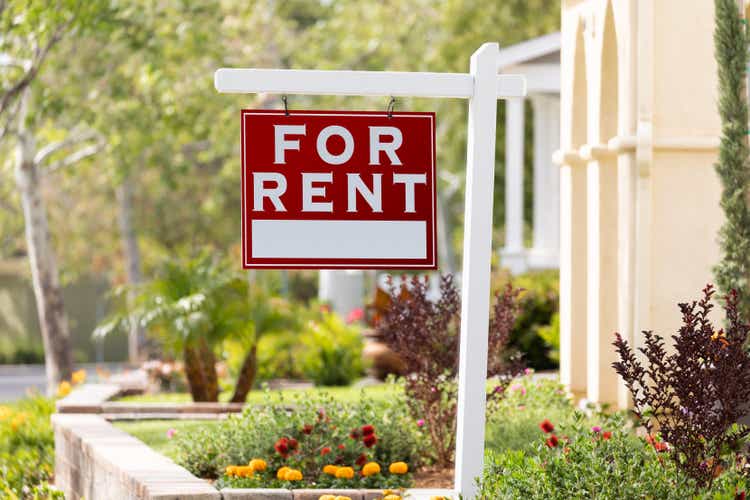
This is an abridged version of the full report published on Hoya Capital Income Builder Marketplace on March 25th.
REIT Rankings: Single-Family Rentals
Single-Family Rental REITs (“SFR REITs”) are one of the great success stories of the Modern REIT Era, becoming a “core” institutional asset class and quieting the critics that questioned their ability to operate efficiently. SFR REITs have been one of the best performing property sectors since their emergence onto the scene in the mid-2010s, outperforming the REIT Index for three straight years entering 2022. In the Hoya Capital Single-Family Rental Index, we track the three SFR REITs: Invitation Homes (INVH), American Homes 4 Rent (AMH), and newly-US-listed Tricon Residential (TCN).
Single-Family Rental REITs – which own nearly 170,000 single-family homes between the three – concentrate heavily on the Sunbelt markets that have experienced the strongest economic growth during the post-GFC recovery and in the early post-pandemic recovery. Last October, Tricon Residential completed its dual-listing in the U.S. in a $570M IPO after trading exclusively on the Toronto Stock Exchange since 2010. Tricon owns and/or operates more than 29,000 homes in 21 markets across the United States and Canada but is concentrated primarily in the U.S. Sunbelt markets. Invitation Homes has a more significant presence on the West Coast and in Florida.
Other major institutional investors involved in the SFR sector include private equity firms Pretium Partners which owns/operates more than 70,000 homes through its Progress Residential platform, Cerberus Capital, which owns more than 34,000 homes through FirstKey Homes, Amherst Group, which owns/operates more than 34,000 homes through Main Street Renewal, and NexPoint, which owns roughly 17,000 homes through Vinebrook Homes, its non-traded REIT that is exploring a potential public listing. NexPoint also manages apartment REIT NexPoint Residential (NXRT) and mortgage REIT NexPoint Real Estate Finance (NREF). Several traditional Wall Street “heavyweights” are active in the space as well including Blackstone (BX), which owns 17,000 homes through Home Partners of America.
While Wall Street’s growing presence in the SFR space has garnered plenty of political and media attention (and “blame” for the rise in home values and rents over the last several years), large institutional investors represent a tiny fraction – roughly 1-2% – of the overall single-family market. Smaller “mom and pop” investors – those that own between 2 and 10 homes and finance purchases with traditional mortgages – are responsible for the bulk of investor home buying activity. That said, we believe that the “institutionalization” of the SFR market remains in the early innings and the recent rise in mortgage rates will be a catalyst to drive further market share gains to larger institutions that have access to cheaper and deeper sources of capital.
We continue to believe that these three SFR REITs are uniquely positioned to benefit from the broader trend of institutionalization within the single-family housing industry and one that we see as a positive development for both renters and investors alike. Consistent with the trends we observe in the multifamily sector – of which 25% is owned by institutional investors – retention rates and occupancy rates are consistently and meaningfully higher for SFR REITs than the national average, indicating high levels of renter satisfaction and operating efficiency. Combined with the effects of the swift rise in mortgage rates over the last three months, households hold a historically high preference towards renting over buying.
Quieting the critics that questioned their ability to operate efficiently, SFR REITs reported the strongest year on record for NOI growth and net operating margins while INVH and AMH both provided guidance calling for continued robust growth throughout 2022. Driving these efficiency gains, SFR REITs have been leaders in the Property Technology (“PropTech”) revolution to reduce costs, increase renter satisfaction, and fuel accretive growth. Honed out of necessity, SFR REITs have leveraged emerging technologies like virtual house tours, Smart Homes, and fully digital relationships with tenants to achieve NOI margins that are nearly on par with multifamily REITs.
Single Family Rental Fundamentals
SFR fundamentals are as strong as they’ve been since the sector emerged in the early 2010s from the ruins of the Great Financial Crisis. The combination of historically low housing supply and strong demographic-driven demand – with added pandemic-driven tailwinds – has sent single-family rents soaring at the fastest rate on record. Mirroring the surge in suburban home values amid this historic and lingering housing shortage, SFR REITs have reported double-digit rent growth in recent months while occupancy rates continue to set record-highs. As discussed in our REIT Earnings Recap, SFR REIT rent growth on new leases averaged 16% while renewal rates rose 7.1%, resulting in blended rent growth of 9.5% – essentially matching the record-high set the prior quarter.
The momentum continued into early 2022, according to recent data from CoreLogic, which reported that SFR rent growth increased 12.6% in January 2022, the fastest year-over-year increase in over 17 years, which also marked the 10th consecutive month of record-level rent growth. CoreLogic noted that rents increased across the country, with Sun Belt cities once again registering the largest gains and commented that rising home values and mortgage rates are “shutting out many would-be homeowners and forcing them to keep renting.” Case Shiller Home Price Index data last month showed that home values rose nearly 19% year-over-year in December.
Apartment List released their March 2022 Rent Report earlier this month, which showed that national rents are 17.6% higher than last year while data from Zillow (Z) showed that rents are rising at the fastest pace on record and all 60 of the largest markets are seeing rent growth in excess of 7.5%. CoreLogic reported that among the 20 metro areas that it tracks, Miami saw the largest year-over-year rental rate increase of 38.6% followed by Orlando at 19.9% while Washington, D.C., had the lowest increase at 5.6%.
As analyzed in REIT Earnings Recap, residential REITs were again the positive standouts in the fourth quarter as the previously red-hot ownership markets have “passed the torch” to rental markets as rents catch up with soaring home prices. While all segments of the rental markets – apartments, SFRs, and manufactured housing – have seen accelerating rent growth throughout 2021, SFR REITs began this recent uptrend from a higher starting-point compared to their multifamily peers following a solid year of growth last year and, interestingly, have delivered consistently higher core revenue and NOI growth compared to the multifamily peers since the start of 2015.
Despite the record-rise in rental rates in 2021, occupancy rates climbed to fresh record-highs at 98% in Q4. Aided by turnover rates which continued to set record-lows, NOI margins set record-highs for full-year 2021 at 66%, levels that are essentially on par with many of their multifamily peers. Invitation Homes delivered the strongest operating performance among these three REITs in 2021 with same-store NOI growth of 9.4% followed by American Homes at 8.7% and Tricon at 7.2%. The momentum is expected to continue into 2022 with all three REITs projecting an acceleration in same-store NOI growth to 9.1% while FFO growth is expected to rise by double-digits for the second-straight year.
Single-Family Rental REITs In ‘Growth Mode’
Despite the recent successes, critics continue to question the long-term sustainability of the institutional stabilized ownership model pioneered by SFR REITs, particularly if home price appreciation consistently outpaces rent growth. This can create a problematic situation for SFR REITs: Future acquisitions can become less accretive as REITs are forced to pay higher prices for the same cash flow. Meanwhile, property taxes and other expense items are generally tied to rising home values. Aided by the PropTech efficiencies discussed above, however, INVH continues to see accretive acquisition opportunities with acquisitions with cap rates in the low-5% range while it has historically sold properties with incredibly low cap rates between 1% and 3%.
SFR REITs have switched back into “growth mode” and continue to plow ahead with external growth plans through both traditional channels and emerging growth channels ranging from ground-up internal development, partnerships with homebuilders, and through the aforementioned iBuyers. Combined, these REITs have added more than $2.2B in net acquisitions over the past year, the highest twelve-month total since late 2016. These three REITs combined to add more than 10,000 homes to their portfolios in 2021 led by Tricon, which added roughly 6,500 homes while American Homes added 4,600 to its portfolio in 2021 while Invitation Homes added 4,000 homes.
Rapid home price appreciation and stiff competition in the “traditional” acquisition channel have forced SFR REITs to get creative with external growth plans. “If you can’t buy it, build it” has been the recent mantra as SFR REITs have effectively become strategic homebuilders through internal development and partnerships with existing builders. AMH – which has quickly become one of the largest homebuilders in the country – built 2,054 homes in 2021 through its internal AMH Development Program and expects to deliver between 2,100 to 2,400 homes in 2022. This internal development now accounts for half of AMH’s acquisitions with the remaining 50% split between its National Builders Program (buying new homes from homebuilders) and traditional acquisitions.
INVH announced a partnership with PulteGroup (PHM) in July to buy 7,500 new built-to-rent homes. Elsewhere, Lennar (LEN) partnered with Allianz to build $4B worth of SFR homes while Toll Brothers (TOL) partnered with Equity Residential (EQR) to build $2B rental units. These REITs have also tapped into the emerging “iBuying” industry to source acquisitions through relationships and direct investments into companies like Opendoor Technologies (OPEN) and Offerpad (OPAD) and leverage data from CoreLogic, CoStar Group (CSGP), Black Knight (BKI), and Redfin (RDFN) to source accretive acquisition opportunities.
Single-Family Rental REIT Performance
One of the newest REIT sectors, single-family rental REITs have produced excellent total returns relative to other REIT sectors in their short history, riding the tailwinds of the intensifying housing shortage across the U.S. housing market. From 2015 through the end of 2021, the SFR sector produced compound annualized total returns of 20.9% per year compared to the 11.7% annual returns from the broad-based Equity REIT Index.
After delivering total returns of 52% in 2021, the SFR REIT sector has taken a breather in early 2022 along with the rest of the REIT sector and broader equity market amid a historically rapid rise in interest rates. Unlike many other interest-rate-sensitive REIT sectors, however, rising interest rates and mortgage rates have historically benefited these SFR REITs as households on the margins of buying or renting tend to be pushed towards rental markets. The Hoya Capital Single-Family Rental REIT Index is lower by 8.6% in 2022, slightly lagging the 8.4% decline from the broad-based Vanguard Real Estate ETF (VNQ) and the 4.7% decline from the S&P 500 ETF (SPY).
Deeper Dive: Macro Housing Fundamentals
Single-family rentals, which combine the benefits of single-family living with the best parts of the multifamily experience, have become the default “starter home” for millions of Americans. Fueled by the maturing millennial generation – the largest age cohort in American history – the 2020s were already poised to be a decade of “suburban revival” and behavioral changes in the post-coronavirus world have provided an added spark and pulled some of this single-family housing demand forward. Whether they’re renting or owning, the maturing millennial generation will enter the single-family housing markets in full force throughout the 2020s in a quantity and magnitude not seen since the young boomers began to flock to the suburbs in the late 1970s.
This booming demand, however, comes at a time of historically low housing supply. New home construction – particularly in the single-family category – has been historically depressed over the last decade, a result of the substantial and far-reaching fallout from the financial crisis on the residential construction industry. In the 2010s, the United States built homes at a rate that was 50% below the post-1960 average after adjusting for population growth. As a result, housing inventory remained near a record low of 870k units in the latest Existing Home Sales report, down by 15% year-over-year. Properties remained on the market for just 18 days in February, down from 19 days in January and 20 days in February 2021. Eighty-four percent of homes sold in February 2022 were on the market for less than a month
Scale is a key competitive advantage for these large institutional SFR owners, and relative to apartment buildings where each property can have several hundred units, geographical fragmentation makes it more difficult to acquire a substantial number of units to achieve scale. Density within markets is especially critical for SFR REITs for achieving efficiencies in leasing, acquisition, and maintenance. We estimate that 500-1,000 units per market are needed to achieve minimum scale, but that 2,000 units or more are needed to reach a “critical mass” whereby the REIT can localize operations within that market and achieve cost efficiencies on par with apartment REITs.
Single-family rental REITs comprise roughly 1-2% of the “Core” REIT ETFs and 5% of the Hoya Capital US Housing Index, the benchmark that tracks the performance of the US Housing Industry. Initially, in a phase we call SFR 1.0, the SFR REIT business model depended on the bulk acquisition of distressed properties, and REITs used foreclosures as a primary source of new home acquisition. In SFR 2.0, the business model evolved into a stabilized ownership model, focused on achieving efficiencies and growing via one-off acquisitions. In SFR 3.0, we see SFR REITs mirroring the model of the larger apartment REITs with internal development teams capable of supplementing the acquisition-fueled external growth channels.
Single-Family Rental REIT Dividend Yields
Single Family Rental REITs are quintessential “Growth REITs” with relatively low dividend yields but with a high potential for dividend growth. Based on dividend yield, SFR REITs rank near the bottom of the REIT universe, paying an average yield of 2.0% compared to the REIT sector average of 3.0%. SFR REITs pay out just half of their available cash flow, however, and dividend growth has averaged more than 15% per year over the last five years, powered by the combination of robust external growth and strong rent growth.
Dividend growth has been especially strong over the past three years during the “pandemic era” as all three REITs have significantly raised their dividends over the past several quarters. After raising its dividend by another 30% last month, Invitation Homes now pays the highest dividend yield in the SFR sector at 2.20%, followed by American Homes at 1.87%, which itself raised its dividend by 80% last month. Tricon, meanwhile, pays a dividend of 1.42% and has delivered more muted dividend growth over the past several years.
Takeaways: Renting The American Dream
The combination of historically low housing supply and strong demographic-driven demand has sent single-family rents soaring at the fastest rate on record. Powered by the historic surge in rents, SFR REITs reported earnings growth of nearly 20% last year and have delivered dividend growth of over 30% per year since the start of the pandemic, and rising mortgage rates have tilted the affordability scale further towards renting. In addition to keeping upward pressure on rents, rising mortgage rates will likely accelerate the expansion of institutional ownership across the SFR space and the maturation of “built-for-rent” single-family development, which we see as key catalysts for SFR REIT growth. We continue to believe that these three SFR REITs are uniquely positioned to benefit from this broader trend of institutionalization which we see as a positive development for both renters and investors alike.
For an in-depth analysis of all real estate sectors, be sure to check out all of our quarterly reports: Apartments, Homebuilders, Manufactured Housing, Student Housing, Single-Family Rentals, Cell Towers, Casinos, Industrial, Data Center, Malls, Healthcare, Net Lease, Shopping Centers, Hotels, Billboards, Office, Farmland, Storage, Timber, Prisons, and Cannabis.
Disclosure: Hoya Capital Real Estate advises two Exchange-Traded Funds listed on the NYSE. In addition to any long positions listed below, Hoya Capital is long all components in the Hoya Capital Housing 100 Index and in the Hoya Capital High Dividend Yield Index. Index definitions and a complete list of holdings are available on our website.


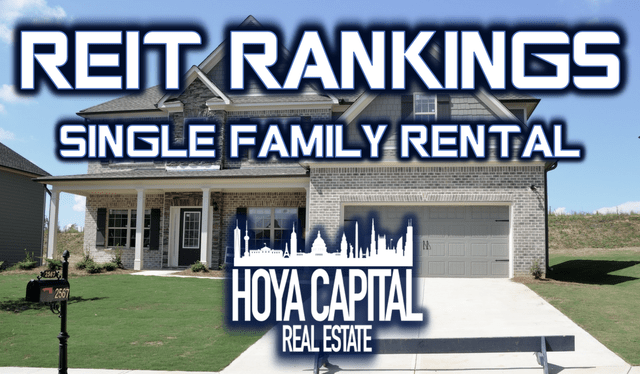
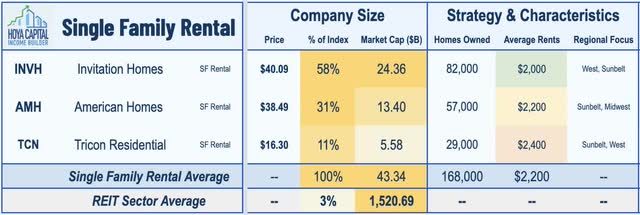
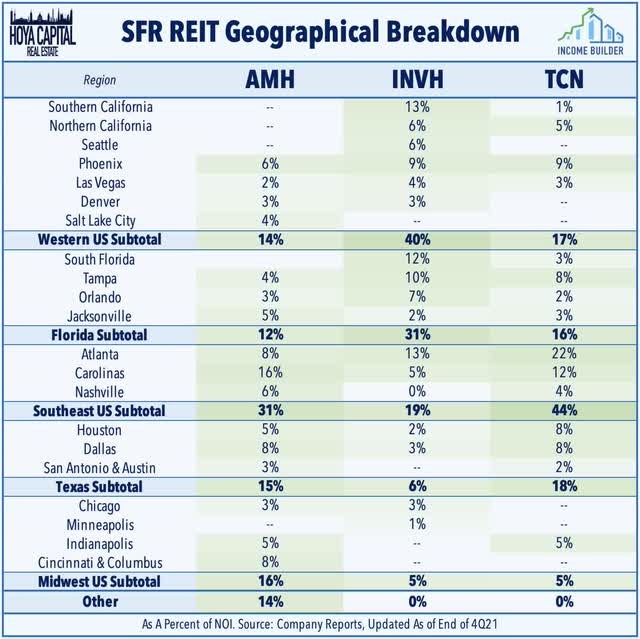
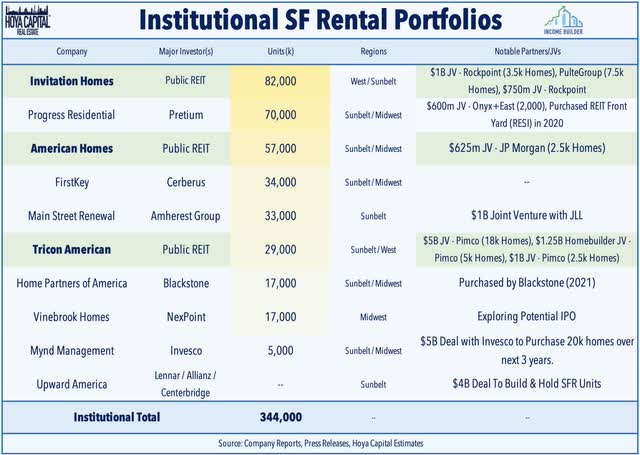
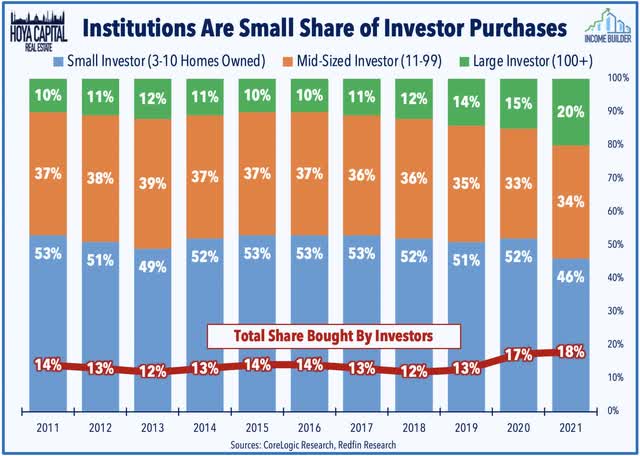
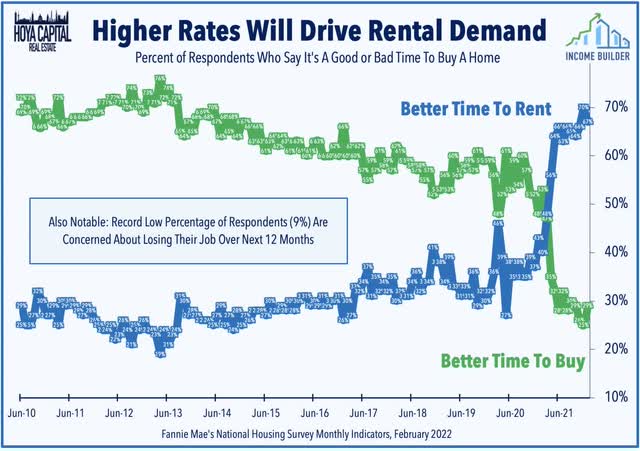
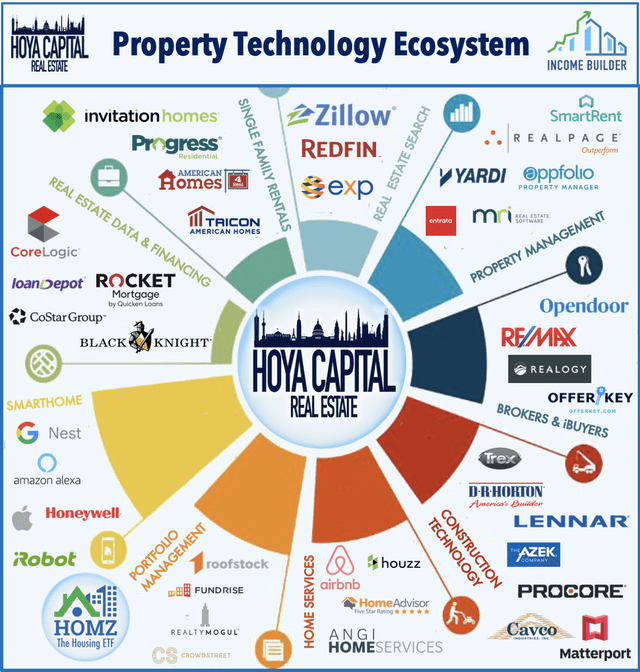
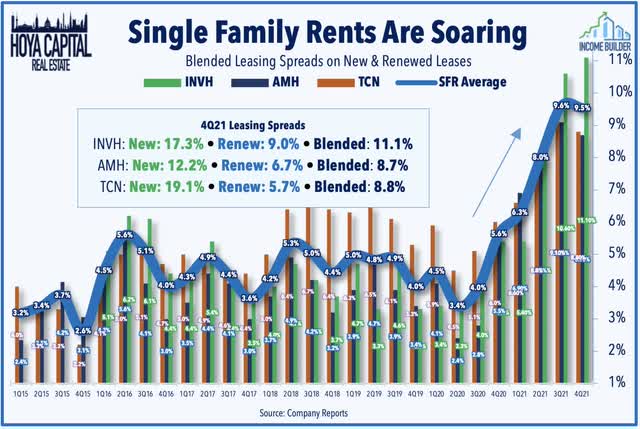
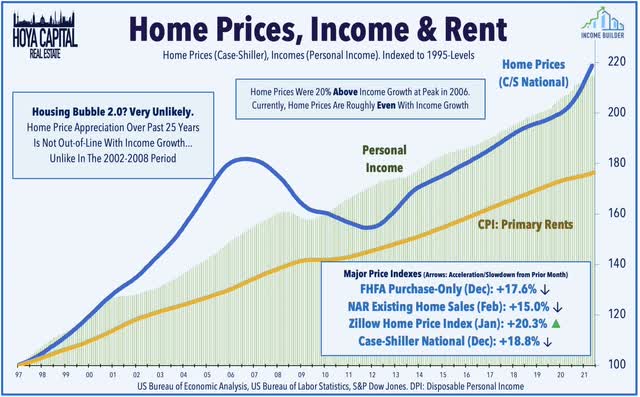
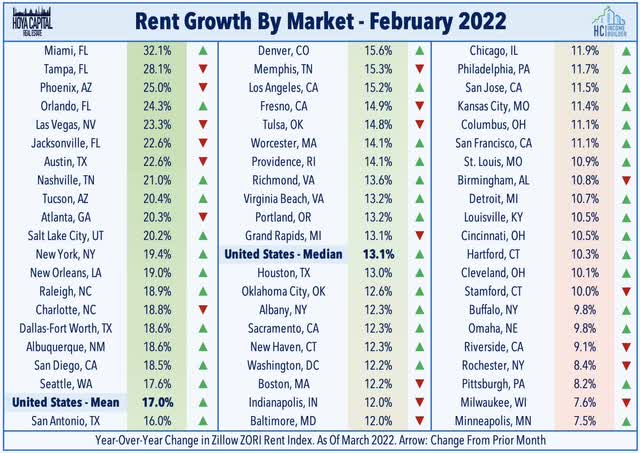
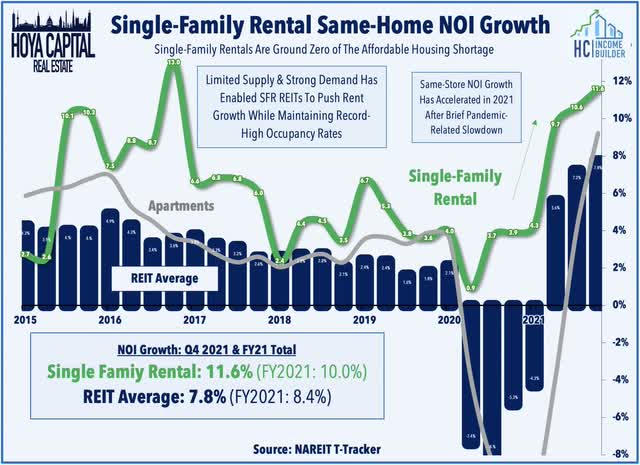
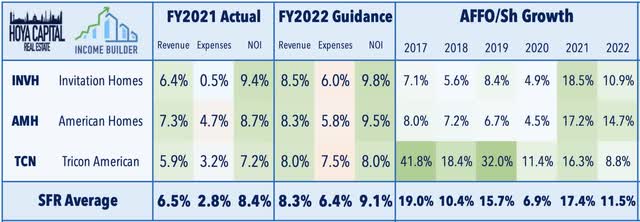
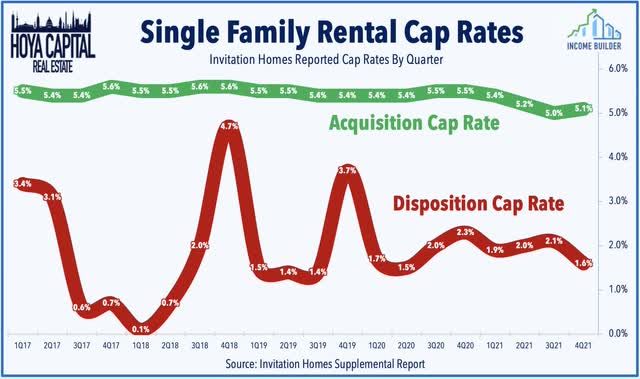
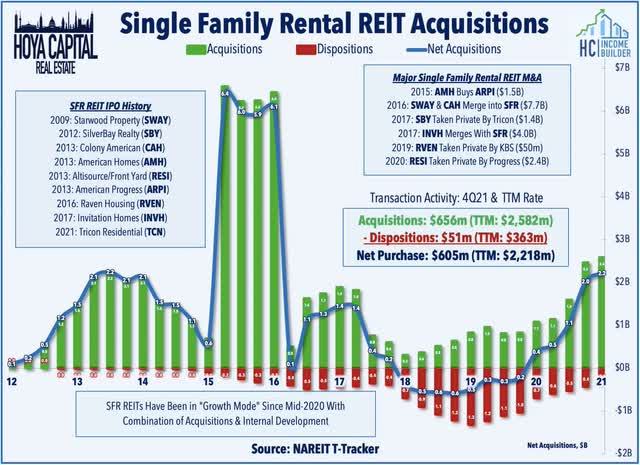
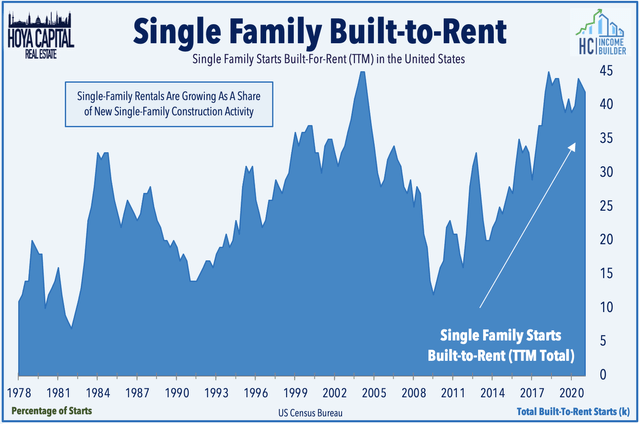
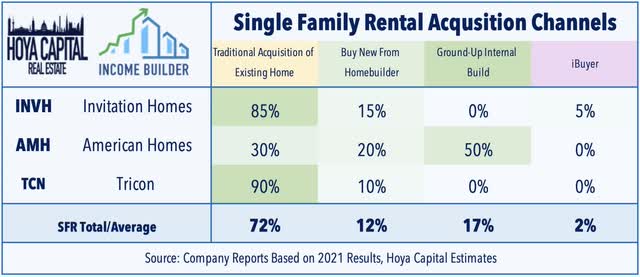
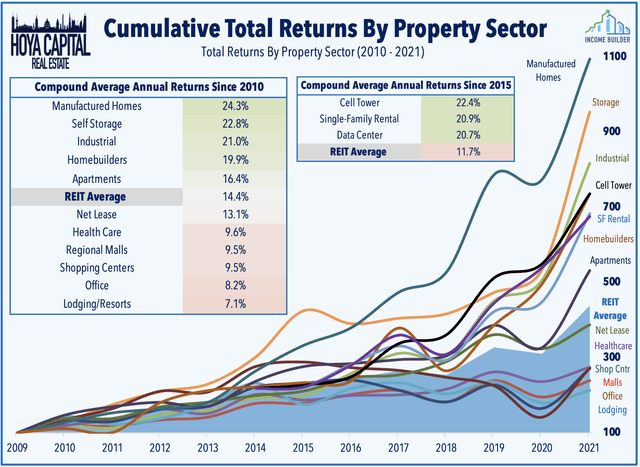
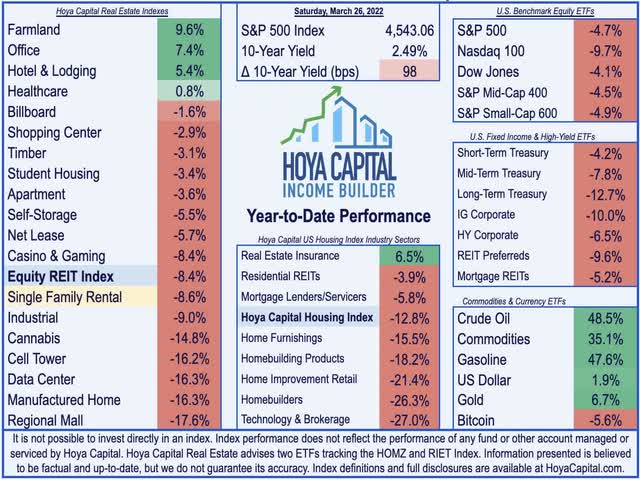
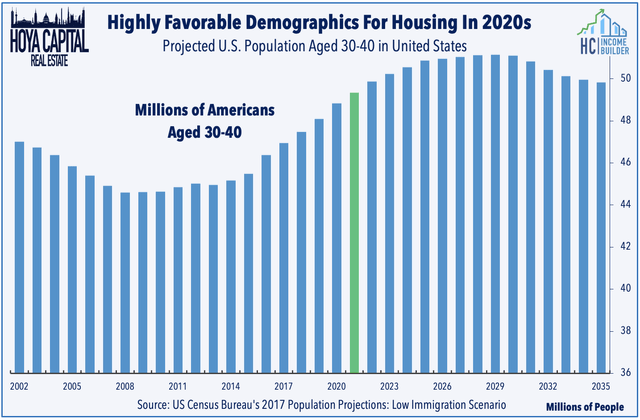
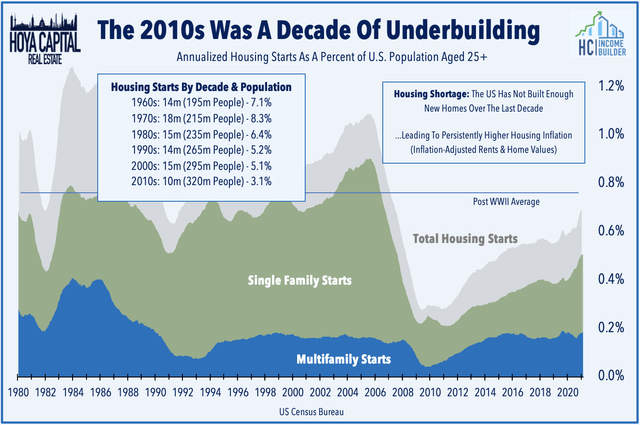
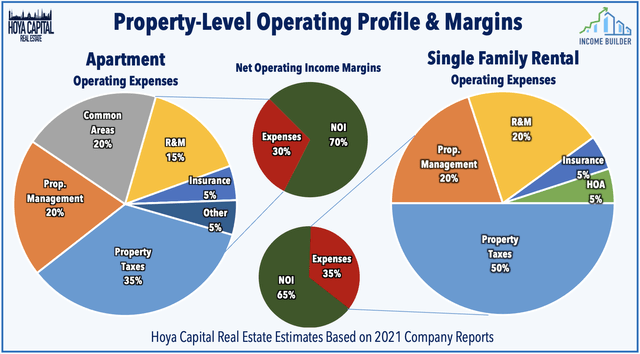
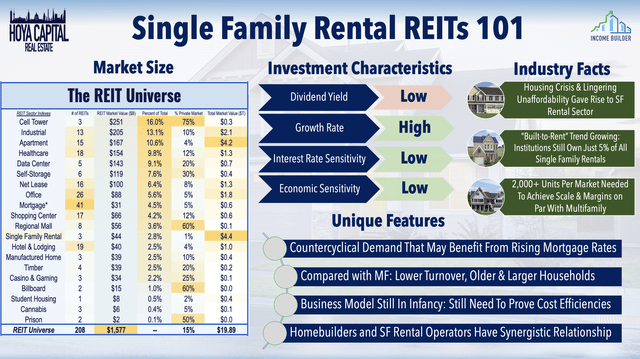
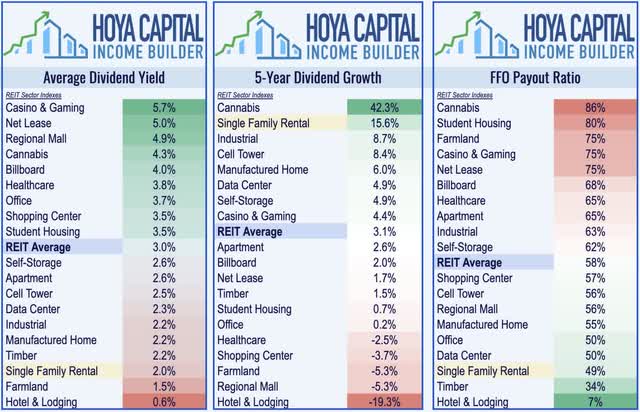
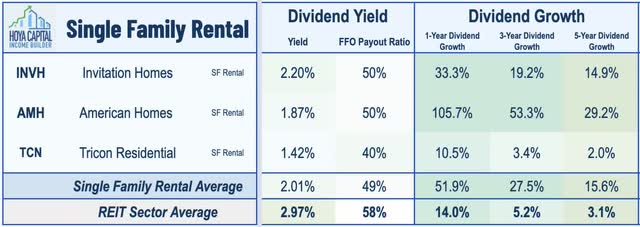
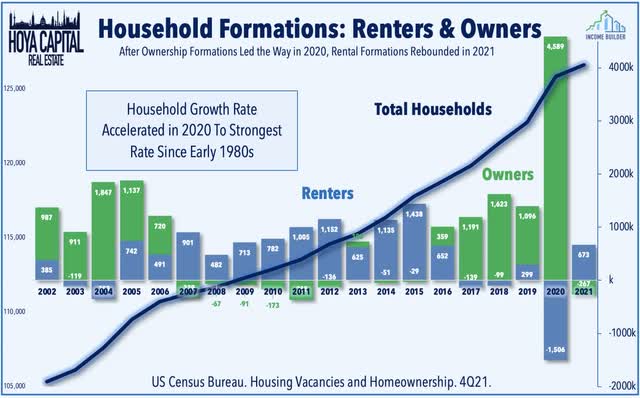
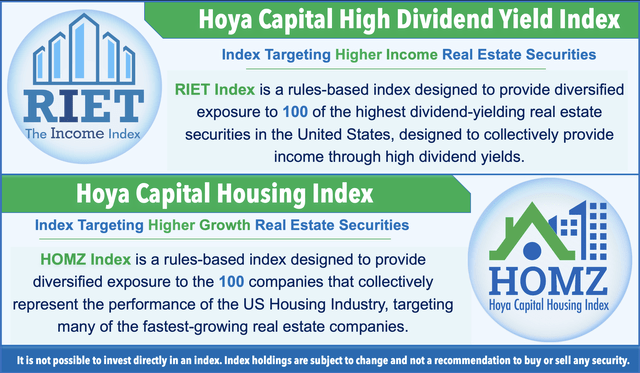
Be the first to comment